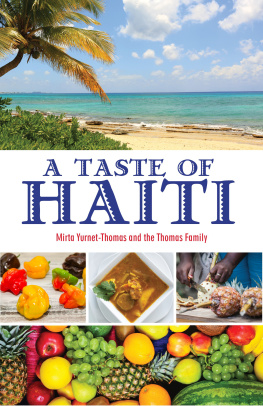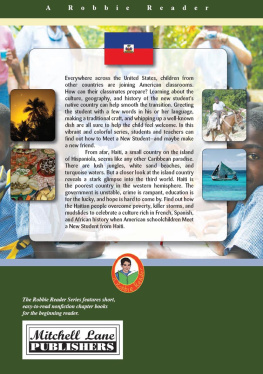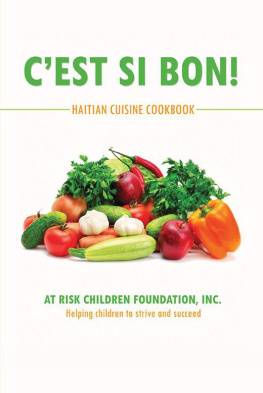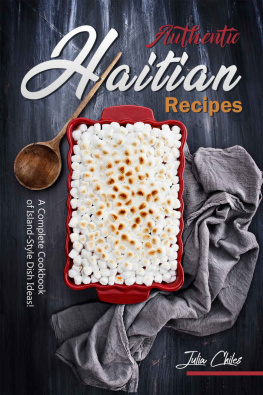 A Taste of Haiti THE HIPPOCRENE COOKBOOK LIBRARY Afghan Food & Cookery African Cooking, Best of Regional Albanian Cooking, Best of Aprovecho: A Mexican-American Border Cookbook Argentina Cooks! Australia, Good Food From Austrian Cuisine, Best of, Exp. Ed. Belgian Cookbook, A Brazilian Cookery, The Art of Bulgarian Cooking, Traditional Burma, Flavors of, Cajun Women, Cooking With Calabria, Cucina di Caucasus Mountains, Cuisines of the Chile, Tasting Colombian, Secrets of Cooking Croatian Cooking, Best of, Exp. Ed. Czech Cooking, Best of, Exp. Ed.
A Taste of Haiti THE HIPPOCRENE COOKBOOK LIBRARY Afghan Food & Cookery African Cooking, Best of Regional Albanian Cooking, Best of Aprovecho: A Mexican-American Border Cookbook Argentina Cooks! Australia, Good Food From Austrian Cuisine, Best of, Exp. Ed. Belgian Cookbook, A Brazilian Cookery, The Art of Bulgarian Cooking, Traditional Burma, Flavors of, Cajun Women, Cooking With Calabria, Cucina di Caucasus Mountains, Cuisines of the Chile, Tasting Colombian, Secrets of Cooking Croatian Cooking, Best of, Exp. Ed. Czech Cooking, Best of, Exp. Ed.
Danube, All Along The, Exp. Ed. Dutch Cooking, Art of, Exp. Ed. Egyptian Cooking Eritrea, Taste of Filipino Food, Fine Finnish Cooking, Best of French Caribbean Cuisine French Fashion, Cooking in the (Bilingual) Greek Cuisine, The Best of, Exp. Ed.
Gypsy Feast: Recipes and Culinary Traditions of the Romany People Haiti, Taste of Havana Cookbook, Old (Bilingual) Hungarian Cookbook Hungarian Cooking, Art of, Rev. Ed. Icelandic Food & Cookery Indian Spice Kitchen International Dictionary of Gastronomy Irish-Style, Feasting Galore Italian Cuisine, Treasury of (Bilingual) Japanese Home Cooking Korean Cuisine, Best of Laotian Cooking, Simple Latvia, Taste of Lithuanian Cooking, Art of Macau, Taste of Mayan Cooking Middle Eastern Kitchen, The Mongolian Cooking, Imperial New Hampshire: From Farm to Kitchen Norway, Tastes and Tales of Persian Cooking, Art of Polands Gourmet Cuisine Polish Cooking, Best of, Exp. Ed. Polish Country Kitchen Cookbook Polish Cuisine, Treasury of (Bilingual) Polish Heritage Cookery, Ill. Ed.
Polish Holiday Cookery Polish Traditions, Old Portuguese Encounters, Cuisines of Pyrenees, Tastes of Quebec, Taste of Rhine, All Along The Romania, Taste of, Exp. Ed. Russian Cooking, Best of, Exp. Ed. Scandinavian Cooking, Best of Scotland, Traditional Food From Scottish-Irish Pub and Hearth Cookbook Sephardic Israeli Cuisine Sicilian Feasts Slovak Cooking, Best of Smorgasbord Cooking, Best of South African Cookery, Traditional South American Cookery, Art of South Indian Cooking, Healthy Spanish Family Cookbook, Rev. Ed.
Sri Lanka, Exotic Tastes of Swiss Cookbook, The Syria, Taste of Taiwanese Cuisine, Best of Thai Cuisine, Best of, Regional Turkish Cuisine, Taste of Ukrainian Cuisine, Best of, Exp. Ed. Uzbek Cooking, Art of Warsaw Cookbook, Old A Taste of Haitiby Mirta Yurnet-Thomas
& the Thomas Family Copyright 2002 Mirta Yurnet-Thomas.
Copyright 2002 Mirta Yurnet-Thomas.
Expanded Edition 2004.
All rights reserved. Book and jacket design by Acme Klong Design, Inc. For more information, address;
HIPPOCRENE BOOKS, INC.
171 Madison Avenue
New York, NY 10016 ISBN 0-7818-0998-3
Cataloging-in-Publication Data available from the Library of Congress.
Printed in the United States of America. ACKNOWLEDGEMENTS I want to thank the following people: My husband, Delille Thomas for inspiring me to write this book and helping me with many facets of the project; my in-laws, Edith, Claude, Dominique, and Danielle for embarking on this journey with me and spending endless hours discussing and testing recipes; Roseann Do Couto, for selecting the color scheme for the cover and helping me draft and retype recipes; Miguel Miggy Do Couto for helping me with the food glossary; Evelyn Julmisse for writing the introduction and giving me endless tips and ideas; my editor, Carol Chitnis-Gress, for believing in the project and providing support along the way; all the contributors of recipes, who invited me into their homes, cooked for me and with me, and cleaned up the mess thereafter; and all the lovely Haitians who have called and emailed me to praise my efforts.
THANK YOU! CONTENTSForeword I come from a family raised on a farm in Isabela, Puerto Rico. My mothers childhood daily chores included feeding livestock, milking cows, picking and grinding coffee beans, and helping to make cheese. I spent all my childhood summers in Isabela. I loved picking fresh fruits and vegetables, helping feed the livestock, grinding fresh coffee beans, and watching the men and women of our family prepare typical beverages, desserts, and foods. At our home, slaughtering and roasting livestock were the norm. Today, our land continues to flourish with avocados, mangos, papayas, lemons, tamarinds, oranges, guavas, guineps, breadfruit, coconuts, beans, and root vegetables.
My family continues to prepare jams, candies and traditional delicacies. Their influence has fostered my passion for natural foods and my fascination with how the environment determines ones sustenance. The first time I tasted Haitian food, at my Haitian mother-in-law Edith Thomas house, I was in love at first bite. Haiti and Puerto Rico share similar ancestral and historical references, and we grow the same fruits, vegetables, and spices. I believe that is why Haitian food tastes so familiar to me. I grew to love it so much I attempted to purchase a Haitian cookbook in the United States but could not find one.
I immediately felt the loss of not having this cuisine documented in America, a country where cookbooks of all types flourish. Hence, my quest to write this book. My husband Delille, his mother Edith, and his sisters Claude, Dominique and Danielle immediately embarked on the journey. They delved into their memories and provided me with many delights, procured the help of their family and friends, and cooked the recipes they knew best while I measured the quantities, time and time again. This was a difficult task because Haitians are not accustomed to using exact measures. They cook by feel, sight and taste.
Others helped along the way, by either inviting me into their homes to teach me how to make certain dishes, by providing suggestions, or by introducing me to people with knowledge of special recipes. Most of these recipes, however, are not meant to be taken too literally. Ingredients like salt, black pepper, bell peppers, picklese, and cooking oil can be altered to suit ones individual tastes or health concerns. Taste what you are preparing as you go along. If you feel it needs more salt, add it; if you are allergic, cook the dish without it. While working on this book, Delille and I traveled to Haiti to visit his homeland that had captured my taste buds.
Haiti, as most know, is a very poor country, but it is incredibly rich in traditions and customs. I was particularly interested in the outdoor food markets, where most of the merchants are women. If you rise very early, you see the women walking down the mountains, balancing their baskets full of produce on their heads, with such grace. Hot peppers, limes, mangos, grapefruits, papayas, avocados, soursops, cherries, root vegetables, sugar cane, djon-djon mushrooms, okra, pumpkins, and molasses are plentiful. When you travel up the mountains, you witness freshly slaughtered cows being sold right on the roads. Live chickens, hens, guinea fowls, and turkeys are also sold by merchants everywhere.
Haitians do not like their photograph taken by strangers. So, I was limited in the photos I was able to comfortably take at the markets for this book. This eclectic cuisine, with its African and French influences, and its touch of Spanish and Indian flavor, is truly delectable. There are many Haitian dishes I was unable to document, simply because I could not get anyone to teach me how to prepare them. However, I would say that this book is a potpourri of many popular Haitian recipes. The recipe names and glossary entries are first presented in English, then Creole and French, because it felt comfortable to present them in that manner, and for no other reason.
Next page











 A Taste of Haiti THE HIPPOCRENE COOKBOOK LIBRARY Afghan Food & Cookery African Cooking, Best of Regional Albanian Cooking, Best of Aprovecho: A Mexican-American Border Cookbook Argentina Cooks! Australia, Good Food From Austrian Cuisine, Best of, Exp. Ed. Belgian Cookbook, A Brazilian Cookery, The Art of Bulgarian Cooking, Traditional Burma, Flavors of, Cajun Women, Cooking With Calabria, Cucina di Caucasus Mountains, Cuisines of the Chile, Tasting Colombian, Secrets of Cooking Croatian Cooking, Best of, Exp. Ed. Czech Cooking, Best of, Exp. Ed.
A Taste of Haiti THE HIPPOCRENE COOKBOOK LIBRARY Afghan Food & Cookery African Cooking, Best of Regional Albanian Cooking, Best of Aprovecho: A Mexican-American Border Cookbook Argentina Cooks! Australia, Good Food From Austrian Cuisine, Best of, Exp. Ed. Belgian Cookbook, A Brazilian Cookery, The Art of Bulgarian Cooking, Traditional Burma, Flavors of, Cajun Women, Cooking With Calabria, Cucina di Caucasus Mountains, Cuisines of the Chile, Tasting Colombian, Secrets of Cooking Croatian Cooking, Best of, Exp. Ed. Czech Cooking, Best of, Exp. Ed. Copyright 2002 Mirta Yurnet-Thomas.
Copyright 2002 Mirta Yurnet-Thomas.